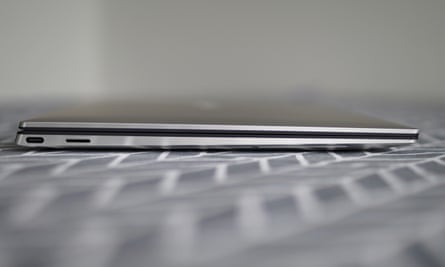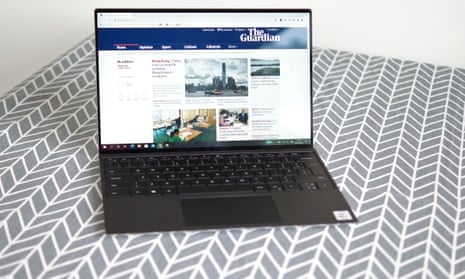Dell’s XPS 13 squeezes more screen, more power and even Windows Hello face recognition into a tiny frame, but trips up over software issues.
The Guardian’s product and service reviews are independent and are in no way influenced by any advertiser or commercial initiative. We will earn a commission from the retailer if you buy something through an affiliate link. Learn more.
The XPS 13 is Dell’s top-of-the-line compact laptop and starts at £1,349. Various models with different processors, storage and screen resolutions are available.
The XPS line is where Dell shows off its design chops. It is a premium Windows 10 rival to Apple’s MacBook Pro and more recently Microsoft’s Surface Laptop line.
Dell’s standout feature has been squeezing the biggest screen possible into as small a frame as possible by shrinking everything in the lid section of the laptop that isn’t screen – much like the modern all-screen smartphone design. The 2020 XPS 13 has the biggest display yet, at 13.4in with a 16:10 ratio, and tiny bezels all the way around the edges.
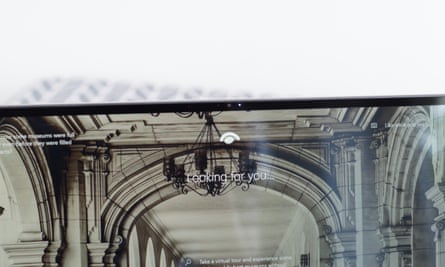
That means you get a relatively large display in the body of what would traditionally have been a laptop with just an 11in screen. And what a screen it is. The version tested had the 4K touchscreen option, which is crisper than practically anything else, super bright, colour accurate and all-round gorgeous. It supports HDR video, including Dolby Vision. Models are available with either touch or non-touch FHD+ screens too.
The body of the laptop is made from aluminium, with your choice of black carbon fibre or white glass fibre on the laptop’s deck. It feels solid, sleek and unique. The wedge-shaped laptop weighs just 1.27kg and is only 14.8mm thick, with a smaller footprint than most of its competition.
The new, slightly larger keyboard is great. Well spaced, stable, fairly quiet, with 1mm of key travel and good feedback when pressed. The large precision trackpad is responsive, with a tactile but muted click that hopefully shouldn’t annoy those around you.
Windows Hello

The XPS 13 ships with not one but two biometric systems for securely logging you into Windows without a password.
The new design has a Windows Hello infrared face recognition camera squeezed into the bezel at the top of the screen and a fingerprint scanner built into the power button. That means you can either log in with a press of the power button or simply by looking at the screen when you open the lid. Both are fast, accurate and work brilliantly.
Specifications
Screen: 13.4in LCD 4K (3840 x 2400) or FHD+ (1920 x 1200)
Processor: 10th-generation Intel Core i5 or i7
RAM: 8 or 16GB
Storage: 512GB or 1TB
Graphics: Intel UHD or Iris Plus
Operating system: Windows 10 Home or Pro, Ubuntu 18.04
Camera: 720p widescreen HD with Windows Hello
Connectivity: Wifi 6, Bluetooth 5.1, 2x USB-C/Thunderbolt 3, microSD, headphone
Dimensions: 198.7 x 295.7 x 14.8mm
Weight: 1.27kg
Hot hardware, but USB-C problems
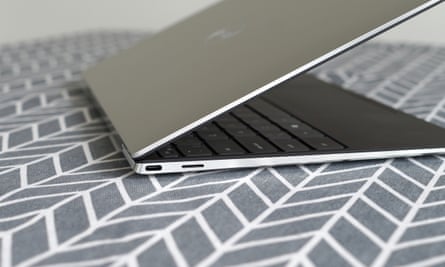
The 2020 XPS 13 ships with your choice of 10th-generation Intel core chips. Most models have the Core i7 common to all top-spec computers, including the new MacBook Pro, Surface Laptop 3 and Huawei MateBook X Pro. The model tested for this review had a Core i7 processor, 16GB of RAM, 512GB of storage and a 4K screen.
As such the XPS 13 has lots of power on tap, making it capable of just about anything, short of high-end gaming. Intel’s Iris Plus graphics are a step up from the previous HD integrated graphics, which you immediately notice when you start editing images on a 4K external screen.
Used on battery the XPS 13 is nearly silent, with only low-level fans audible when pushed a little. Connect the machine to power and start doing demanding things and it will get a bit hot, with the fans going fairly strong. Even with fans at maximum, they’re not quite as loud as some competitors.
The deck of the laptop doesn’t get overly warm, but you could feel some heat behind the R, T, Y, U and I keys. The vents on the bottom of the laptop are easily blocked by soft furnishings, meaning the machine really needs to be used on a hard table, desk or lap.
The XPS 13 has two USB-C/Thunderbolt 3 ports, a headphones socket and a microSD card slot, which is very welcome. When one USB-C port is taken up by the charger, that only leaves one port for connecting accessories, such as a monitor, meaning you might need a dock or similar if using home-working tools.
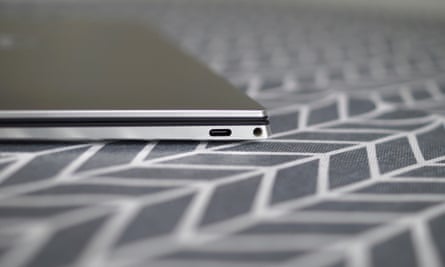
A bug in a BIOS update for the XPS 13 broke compatibility with some USB-C to HDMI adaptors while I was reviewing the machine. The laptop threw up errors for two adaptors after the update, but continued to work with a USB-C to HDMI cable and a USB-C to DisplayPort dock. The bug remained until the end of the review period.
A Dell spokesperson said: “We’re investigating the issue and will update on our findings. We thank customers for sharing their experience on the Dell Community.”
Battery life wasn’t great, averaging only five and half hours of work between charges, including 90 minutes of photo editing, lots of browsing and word processing, with the screen brightness set to 70%. The 2020 MacBook Pro and Microsoft Surface Laptop 3 each lasted 7.5 hours under similar conditions. Lighter use saw closer to seven hours between charges. Models with the lower-resolution FHD+ screen, rather than 4K, will are likely to last significantly longer as the screen is one of the biggest power drains.
A full charge took 2.5 hours with the included 45W USB-C charger in optimised mode, but well under two if using Dell’s fast-charge setting with the laptop off.
Sustainability
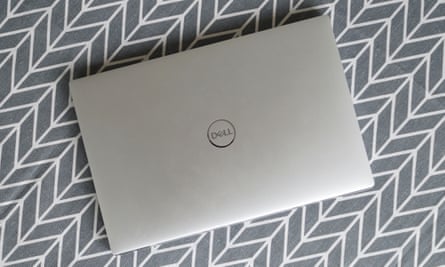
The XPS 13 is one of the most recyclable laptops you can buy, and is generally repairable. It is designed to enable repairs by authorised service personnel in the field, not just in a service centre, including replacement of the battery.
An out-of-warranty screen repair costs £299.41, while a battery replacement costs £171.66. Dell also has an advanced power-management utility that can extend the useful lifespan of a battery by altering when, how and how much it is charged, either automatically by learning from your usage and charging habits or manually via various profiles.
Dell offers free recycling schemes, even for products from other brands, while its packaging is made from recycled materials. The firm has a number of sustainability and environmental impact schemes under way for 2030, including the recycling or reuse an equivalent product per purchase and use of recycled material. Dell publishes the carbon footprint of its products.
Windows 10 Home
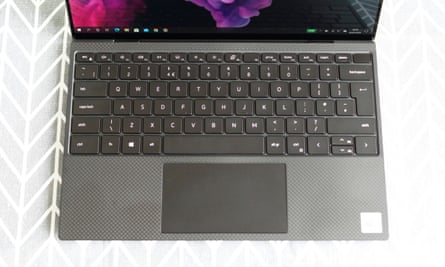
The XPS 13 ships with a choice of Windows 10 Home or Pro, and it is one of the few laptops that can be bought with Linux instead of Windows, with Ubuntu 18.04 models.
As tested with Window 10 Home, the XPS 13 ships with a lot of Dell utility apps, most of which are useful, such as the advanced Dell Power Manager. Many can be safely ignored or removed, but one particular utility for the included wifi chips caused no end of trouble.
The Killer Networking utilities, which are advanced software components for the gaming wifi chip Dell chose to use here, prevented the machine from going to sleep when the lid was shut, which is a cardinal sin for a laptop as it can lead to it turning on in a bag and cooking itself.
No update, clean install or troubleshooting could fix the sleeping issue. Disabling the Killer utilities with the manufacturer-provided tool was the only way to fix it. Killer Networking chips, made by Rivet Networks (recently acquired by Intel), are aimed at gamers and allow traffic prioritisation and other advanced features, but are notorious for causing these sorts of software problems, which makes it a puzzling inclusion in the XPS 13, which is by no means a gaming laptop.
Observations
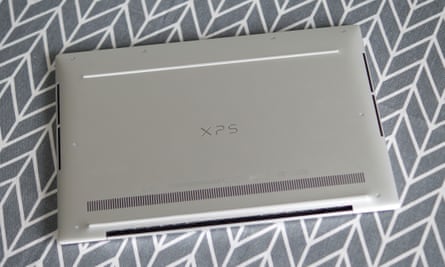
Occasionally the laptop would come back from sleep with Bluetooth disabled, requiring a reboot.
The mics were poor for video conferencing at a distance, but the camera was pretty good.
The down-firing speakers could get very loud indeed, but lacked any bass and were pretty shrill.
There’s an option to turn on the laptop when the lid is opened, even if the XPS 13 is fully powered off.
Price
The Dell XPS 13 (9300) 2020 with Windows 10 Home, a FHD+ non-touchscreen, 8GB of RAM and 512GB SSD costs £1,399 with a Core i5 processor or £1,549 with a Core i7 processor.
The models with a FHD+ non-touchscreen, Core i7 and 16GB of RAM cost £1,599 with 512GB SSD or £1,699 with 1TB SSD. The model with a FHD+ touchscreen, Core i7, 16GB of RAM and 1TB SSD costs £1,749.
The models with a 4K touchscreen, Core i7, 16GB of RAM cost £1,749 with 512GB SSD (as reviewed) and £1,799 with 1TB SSD. Some models are also available in white.
Ubuntu Linux models cost £1,349 with a FHD+ non-touchscreen, Core i5, 8GB of RAM and 512GB SSD, £1,699 with a 4K touchscreen, Core i7, 16GB of RAM and 512GB SSD, or £1,749 with 1TB SSD.
For comparison, the Microsoft’s Surface Laptop 3 starts at an RRP of £999, the Huawei MateBook X Pro costs from £1,299.99 and the 13in MacBook Pro starts at £1,299.
Verdict
The Dell XPS 13 is a fantastic laptop held back by a few failures, most of which are issues traditionally associated with Dell and others.
The design, build, look and physical function of the laptop is top-class. The 4K screen is simply gorgeous, with tiny bezels all around. At 13.4in on the diagonal with a 16:10 ratio, it has a surprisingly large amount of real estate for getting work done, while videos obviously look stunning. It really is a very large screen for such a small laptop.
The keyboard and trackpad are great, and so is having Windows Hello in both an IR face recognition camera and a fingerprint sensor.
There’s plenty of power on tap for doing everything you could want from a 13in laptop outside of gaming. Two Thunderbolt ports, a headphones socket and a microSD card slot are very welcome. It could do with one more USB-C or USB-A port, but not many machines have more than two USB-C ports these days. Battery life could also be better, but if you want it to last longer then buy the one without the 4K screen.
The big issues are the fights I’ve had to have with the add-on Killer Networking utilities, which required disabling to get the laptop to sleep properly, and the bug in the BIOS update that crippled a few of my USB-C to HDMI adaptors. These are things that should not happen in a premium laptop costing this much.
The Dell XPS 13 is a five-star laptop hampered by problems traditionally associated with Dell and other third-party manufacturers that give Windows computers a bad name, which is a real shame.
Pros: fantastic screen, great design, good keyboard, good trackpad, Thunderbolt 3, USB-C, microSD card slot, 10th-gen Intel chips.
Cons: short battery life, only two USB-C/Thunderbolt 3 ports, software/BIOS issues, expensive, mics not great for video conferencing at a distance, speakers are shrill.
